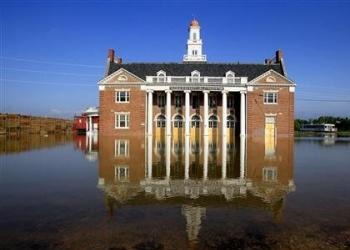Update on Mississippi River Flooding

The swollen Mississippi River continues moving southward toward New Orleans. It is expected to crest at Vicksburg at levels not seen since the great flood of 1927.
The levees are holding but there now is a danger the river could change its course into the more direct route of the Atchafalaya River. Should this happen a major threat to the port of New Orleans would exist. The Army Corps of Engineers would have to dredge a new canal to return normal water flows to the current Mississippi channel.
Throughout American history New Orleans has been a key port and transportation outlet and inlet for oil, cotton, fertilizer and other goods. Seizing control of the the city from the British in the Battle of New Orleans in 1815 was a significant event. Maintaining the ports viability is vital to the countries still fragile economic recovery.
Stratfor compares the impact of a river diversion away from New Orleans as an event on the scale of Hurricane Katrina:
There’s no way to forecast whether or not the Mississippi River will ultimately change its flow into the Gulf of Mexico, and the U.S. Army Corps of Engineers does still have options. It can, for example, open the Morganza control structure, preventing the flooding of New Orleans. However, if such an event was to happen, it would be as geopolitically significant as Katrina if not more because it would essentially end New Orleans’ existence as a key part of American transportation and energy infrastructure.
The Mississippi has a mind of its own. An intricate system of flood control with levees and canals has managed to prevent massive losses since the last great flood of 1927. The best account of this event is told in John Barry's book, Rising Tide: The Great Mississippi Flood of 1927 and How It Changed America. Barry shows just how powerful the river is and how it is different from any of the other great world rivers. "The Mississippi never lies at rest. It roils. It follows no set course".
